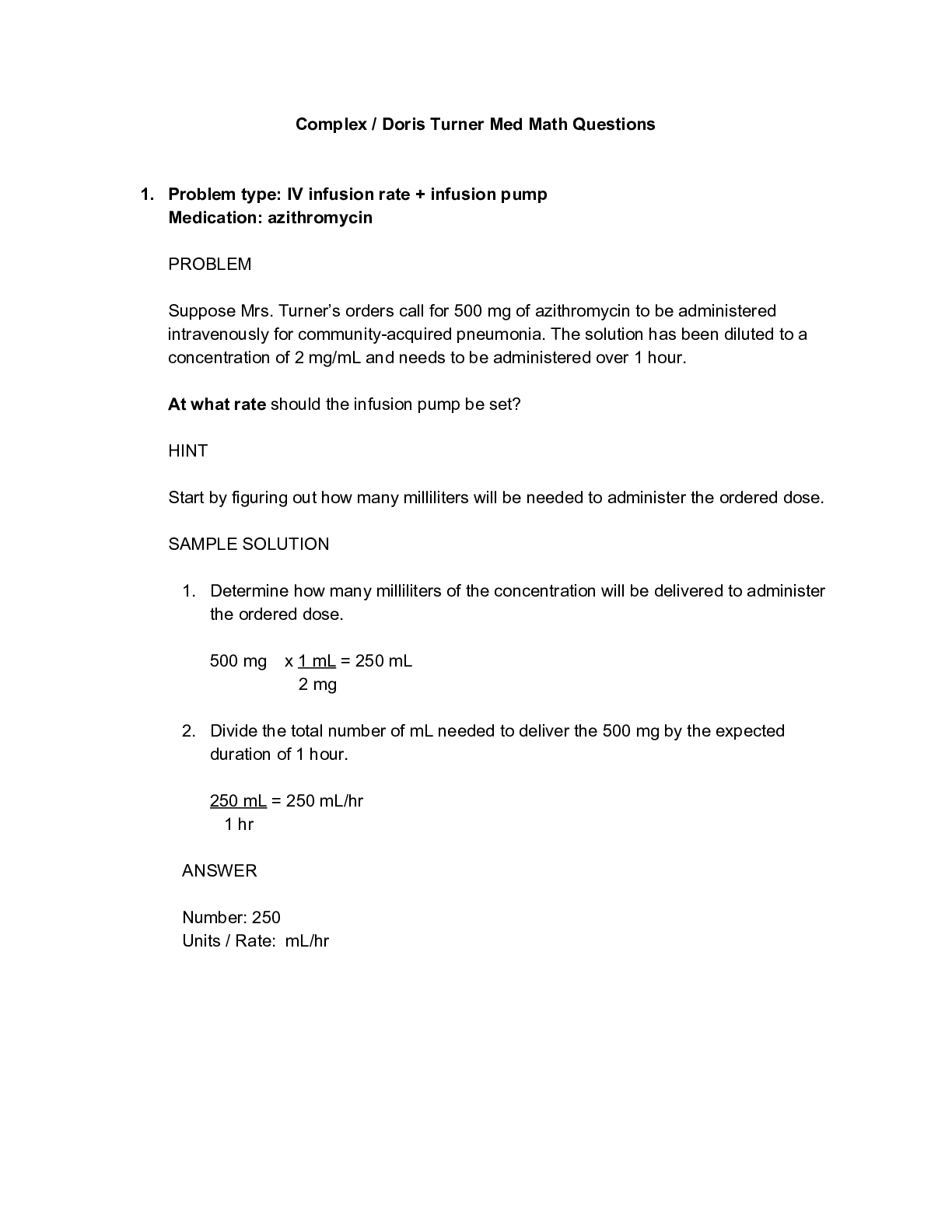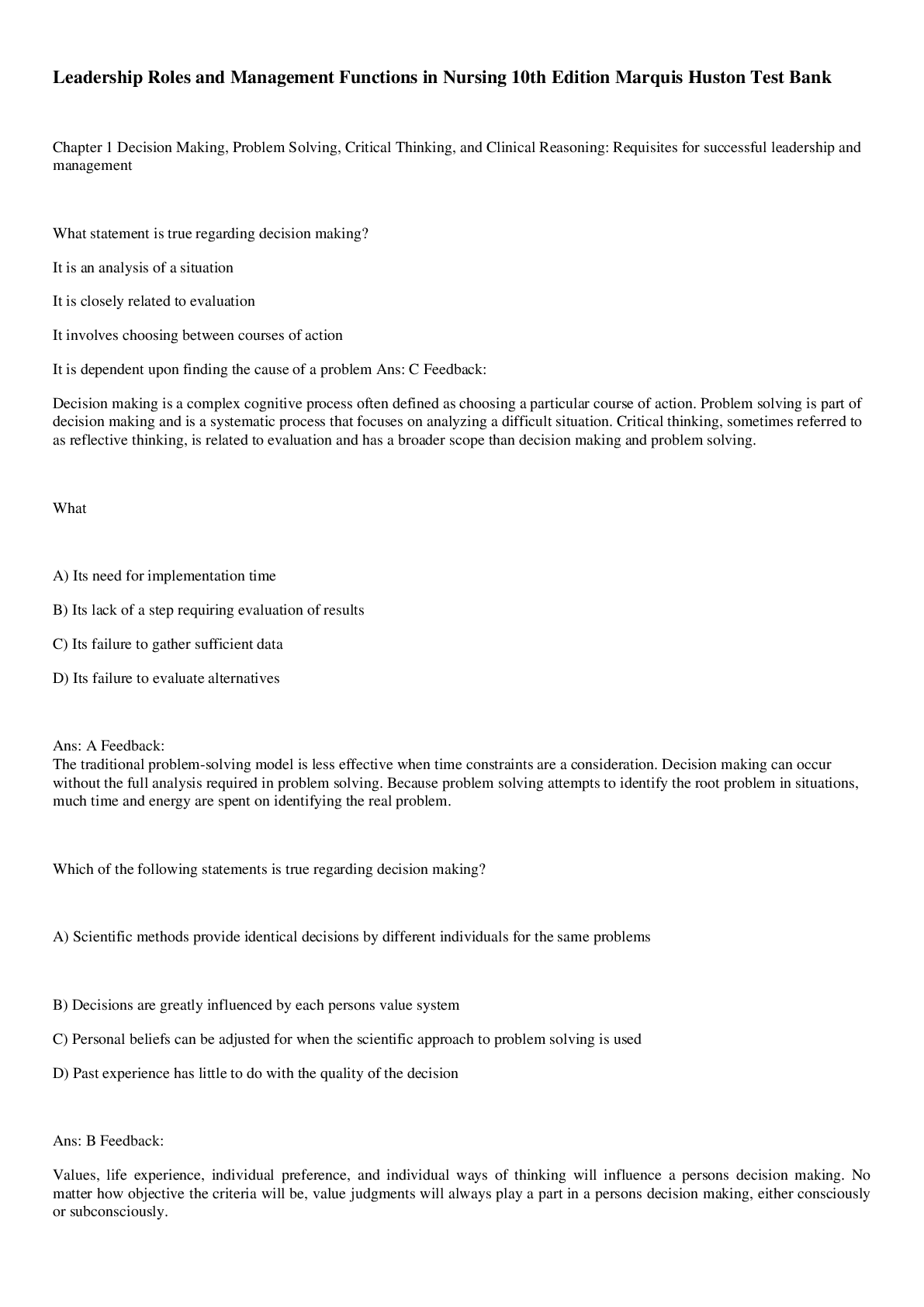Economics > QUESTIONS & ANSWERS > ECONOMICS 501 Final Questions Study Guide. (All)
ECONOMICS 501 Final Questions Study Guide.
Document Content and Description Below
Chapter 2 Question 1: What do economists mean by scarcity? a. Economists mean that unlimited wants exceed limited resources. b. Economists mean that trade is not possible. c. Economists mean that p... eople are not employed. d. Economists mean that production is inefficient. e. Economists mean that economy is unable to produce increasing quantities of goods and services What of the following is not scarce according to the economic definition? a. Coal b. Time c. Food d. Capital e. None of the above Chapter 2 Question 2: A production possibilities frontier: a. Shows the market for a good or service b. Shows how unlimited wants exceed the limited resources available to fulfill those wants c. Shows how participants in the market are linked d. Shows the maximum attainable combinations of two goods that may be produced with available resources. We can show economic efficiency: a. With points inside the production possibilities frontier b. With points on the production possibilities frontier c. With points inside and on the production possibilities frontier d. With points on and outside the production possibilities frontier e. With points outside the production possibilities frontier We can show economic inefficiency: a. With points inside the production possibilities frontier b. With points on the production possibilities frontier c. With points inside and on the production possibilities frontier d. With points on and outside the production possibilities frontier e. With points outside the production possibilities frontier The production possibilities frontier will shirt outward: a. If technological advances occur. Chapter 2 Question 3: What does increasing marginal opportunity costs mean? a. The economy is unable to produce increasing quantities of good and services. b. Increasing the production of a good requires decreases in the production of another good c. Production is not occurring on the production possibilities frontier d. Increasing the production of a good requires smaller and smaller decreases in the production of another good e. Increasing the production of a good requires larger and larger decreases in the production of another good What are the implications of this idea for the shape of the production possibilities frontier? a. The production possibilities frontier will be bowed inward b. The production possibilities frontier will have a negative slope c. The production possibilities frontier will be a straight line d. The production possibilities frontier will have a positive slope. e. The production possibilities frontier will be bowed outward. Chapter 2 Question 4: GRAPH Consider the production possibilities frontier (PPF) that shows the trade-off between the production of cotton and the production of soybeans depicted in the figure to the right. Use the three-point curved line drawing tool to show the effect that improved fertilizers/prolonged drought would have on the initial production possibilities frontier by drawing a new production possibilities frontier. Properly label this curve. Chapter 2 Question 5: GRAPH Consider the production possibilities frontier (PPF) that shows the trade-off between the production of cotton and the production of soybeans depicted in the figure to the right. Suppose that genetic modifications make soybeans resistant to insects, allowing yields to increase. Use the three-point curved line drawing tool to show the effect of this technological change by drawing a new production possibilities frontier. Properly label this curve. Chapter 2 Question 6: GRAPH One of the trade-offs BMW faces is between safety and gas mileage. For example, adding steel to a car makes it safer but also heavier, which results in lower gas mileage. Use the three-point curved line drawing tool to draw a hypothetical production possibilities frontier that BMW engineers face that shows this trade-off. Assume that this trade-off is consistent with increasing costs of added safety. Properly label this curve. Chapter 2 Question 7: Suppose you win free tickets to a movie plus all you can eat at the snack bar for free. Would there be a cost to you to attend this movie? a. No because the movie ticket and snacks at the bar are free. b. No because the movies are not scarce c. No because the movie ticket is free d. Yes because attending movies is not on the production possibilities frontier e. Yes because the movie’s opportunity cost is equal to the highest-valued alternative that must be given up to attend the movie. Chapter 2 Question 8: Suppose we can divide all the goods produced by an economy into two types: consumption goods and capital goods. Capital goods, such as machinery, equipment, and computers, are goods used to produce other goods. Is it likely that the production possibilities frontier in this situation would be a straight line: or bowed out? a. The production possibilities frontier would likely be bowed out because not all resources are equally well suited to produce both consumption and capital goods. Chapter 2 Question 9: GRAPH Suppose we can divide all the goods produced by an economy into two types: consumption goods and capital goods. Capital goods, such as machinery, equipment, and computers, are goods used to produce other goods. Suppose a technological advance occurs that affects the production of capital goods but not consumption goods. Use the three-point curved drawing tool to show the effect of this technological change by drawing a new production possibilities frontier. Properly label this curve. Chapter 2 Question 10: GRAPH Suppose we can divide all the goods produced by an economy into two types: consumption goods and capital goods. Capital goods, such as machinery, equipment, and computers, are goods used to produce other goods. Suppose that country A and country B currently have identical production possibilities frontiers but that country A devotes only 5 percent of its resources to producing capital goods over each of the next 10 years, whereas country B devotes 30 percent. Which country is likely to experience more rapid economic growth in the future? a. Country B Use the three-point curved drawing tool to illustrate this by drawing two production possibilities frontiers. Specifically, your graph should include production possibilities frontiers for country A in 10 years (the future) and production possibilities frontiers for country B in 10 years (the future). Properly label the curves. Chapter 2 Question 11: What is absolute advantage? a. The ability to produce more of a good or service than competitors using the same amount of resources. What is comparative advantage? a. The ability to produce a good or service at a lower opportunity cost than other producers. Is it possible for a country to have a comparative advantage in producing a good without also having an absolute advantage? A country without an absolute advantage in producing a good: a. Will have a comparative advantage if it has a lower opportunity cost of producing that good. Chapter 2 Question 12: What is the basis for trade? a. Comparative advantage How can a country gain from specialization and trade? a. A country can specialize in producing that for which it has a comparative advantage and then trade for other needed goods and services. Chapter 2 Question 13: GRAPH The graph to the right shows how many pounds of apples and pounds of cherries you and your neighbor can each pick in one week. For example, if you devote all of your time to picking apples and none of your time to picking cherries, you can pick 12 pounds of apples. If you devote all of your time to picking cherries, you can pick 72 pounds. At the same time, if your neighbor devotes all of her time to picking apples, she can pick 32 pounds of apples. If she devotes all of her time to picking cherries, she can pick 32 pounds. Suppose initially that you (Y) are consuming 8 pounds of apples and 24 pounds of cherries and that your neighbor (N) is consuming 4 pounds of apples and 28 pounds of cherries, as indicated in the graph. Then, suppose you and your neighbor specialize by each only picking the good for which you have a comparative advantage and trade. In particular, suppose you trade your neighbor half of your production for half of what your neighbor produces. In the table below, first fill in production when specializing. Next fill in consumption with trade. Recall that you trade your neighbor half of what you pick for half of what your neighbor picks. Finally, fill in gains from trade. Chapter 2 Question 14: GRAPH Using the same amount of resources, the United States and Canada can both produce lumberjack shirts and lumberjack boots, as shown in the production possibilities frontiers in the figure to the right. The United States has a comparative advantage in producing lumberjack boots. Canada has a comparative advantage in producing lumberjack boots. Does either country have an absolute advantage in producing both goods? a. Neither country has an absolute advantage in both goods because the United States can produce more boots but Canada can produce more shirts. Suppose initially that the United States is consuming 18 boots and 2 shirts and Canada is consuming 4 boots and 8 shirts, as indicated in the figure. Then, suppose the United States and Canada specialize by each only producing the good for which they have a comparative advantage and then trade. In particular, suppose the United States trades Canada half of its production for half of what Canada produces. The United States will have 10 additional shirt(s) after the trade and 0 additional boot(s). At the same time, Canada will be able to consume 4 additional shirt(s) as a result of the trade and 14 additional boot(s). Chapter 2 Question 15: In the 1950’s, the economist Bela Balassa compared 28 manufacturing industries in the United States and Britain. In every one of the 28 industries, Balassa found that the United States had an absolute advantage. In these circumstances, would there have been any gain to the United States from importing any of these products from Britain? Explain. a. Even with an absolute advantage, the United States would have benefited from importing those products for which Britain had a comparative advantage. Chapter 2 Question 16: CHART Suppose Iran and Iraq both produce oil and olive oil. The following table shows combinations of both goods that each country can produce in a day, measured in thousands of barrels. Who has the comparative advantage in producing oil? a. Neither country has a comparative advantage producing oil because their opportunity costs of producing oil are equal. Can these two countries gain from trading oil and olive oil? a. These countries cannot gain from trade because neither has a comparative advantage producing either good. Chapter 2 Question 17: CHART Suppose that France and Germany both produce wine and schnitzel. The table below shows combinations of the goods that each country can produce in a day. Who has the comparative advantage in producing wine and who has the comparative advantage in producing schnitzel? a. France has a comparative advantage producing wine and Germany has a comparative advantage producing schnitzel. Suppose that France is currently producing 1 bottle of wine and 12 pounds of schnitzel and Germany is currently producing 3 bottles of wine and 10 pounds of schnitzel. Then, assume instead that France and Germany specialize by producing only the good for which they have a comparative advantage and then trade 3 bottles of wine for 13 pounds of schnitzel. After specialization and trade, France gains by consuming the same amount of wine and 1 additional pound(s) of schnitzel and Germany gains by consuming the same amount of wine and 2 additional pound(s) of schnitzel. Chapter 2 Question 18: What is the circular-flow diagram and what does it illustrate? a. The circular-flow diagram shows how households and firms are linked through product and factor markets. Chapter 2 Question 19: What are the two main categories of participants in markets? a. Firms and households Which participants are of greatest importance in determining what goods and services are produced? a. Households. Chapter 2 Question 20: What is a free market? a. A free market is one where the government does not control the production of goods and services. In what ways does a free market economy differ from a centrally planned economy? Unlike a free market economy, a. Centrally planned economies have extensive government controls. Chapter 2 Question 21: What is an entrepreneur? a. Entrepreneurs operate businesses that produce goods and services. Why do entrepreneurs play a key role in a market system? a. They bring together factors of production. Chapter 2 Question 22: Firms are likely to produce more of a good or service when its price rises and less of a good or service when its price falls. Chapter 2 Question 23: What are private property rights? Private property rights are: a. The rights individuals and firms have to the exclusive use of tangible, physical property and intellectual property. What role do they play in the working of a market system? Private property rights: a. Both a and b – encourage a significant number of people to be willing to risk funds by investing them in business. Encourage firms to spend money on research and development. Why are independent courts important for a well-functioning economy? Independence is necessary for courts: a. All of the above – to make their decisions from of influence from people with powerful political connections, free of intimidation by criminal gangs, based on the law, free of influence from other parts of government. Chapter 2 Question 24: Identify whether each of the following transactions will take place in the factor market or in the production market and whether households or firms are supplying the good or service or demanding the good or service. George buys a BMW X5 SUV. This takes place in the product market. The household demands the good the firm supplies the good. BMW increases employment at its Spartanburg plant. This takes place in the factor market. The households supply the labor and the firm demands the labor. George works 20 hours per week at McDonald’s. This takes place in the factor market. The household supplies the labor and the firm demands the labor. George sells land he owns to McDonald’s so it can build a new restaurant. This takes place in the factor market. The household supplies the factor of production and the firm demands the factor of production. Chapter 2 Question 25: In The Wealth of Nations, Adam Smith wrote the following: “It is not from the benevolence of the butcher, the brewer, or the baker, that we expect our dinner, but from their regard to their own interest.” What did Smith mean by this? a. Pursuing their own self-interest, entrepreneurs produce the goods and services most desired by their customers for financial reward. Chapter 3 Question 1: GRAPH Below are both a demand schedule and a demand curve. Which one is best suited to find the quantity demanded at a price of $4.00? The demand schedule. Chapter 3 Question 2: What do economists mean when they use the Latin expression ceteris paribus? a. All else equal Chapter 3 Question 3: GRAPH Use the point drawing tool to show a change in demand given the combinations of price and quantity-demanded shown at point A. Chapter 3 Question 4: The law of demand is the assertion that a. The quantity demanded of a product is inversely related to its price. An increase in the price of a product causes a decrease in quantity demanded because of the income and substitution effects. More specifically, a. The substitution effect is the decrease in quantity demanded because the product is more expensive relative to other goods and the income effect is the decrease in quantity demanded owning to the decline in consumers’ purchasing power. Chapter 3 Question 5: GRAPH A grilled cheese sandwich is considered to be a normal good. Use the line drawing tool to show how a decrease in consumer income affects the demand for grilled cheese sandwiches. Label this new line ‘D2’. Chapter 3 Question 6: GRAPH Jiffy peanut butter and Smucker’s Strawberry jam are considered to be complementary goods. Use the line drawing tool to show how an increase in the price of Jiffy peanut butter affects the demand for Smucker’s Strawberry jam. Label this new line ‘D2’. Chapter 3 Question 7: GRAPH Below are both a supply schedule and a supply curve. Which one is best suited to find the quantity supplied at a price of $4.50? The supply curve. Chapter 3 Question 8: The difference between a change in supply and a change in the quantity supplied is that the latter is a. Displayed graphically as a movement along a supply curve while the former is shown as a shift in the supply curve. Chapter 3 Question 9: From the list below, select the variable that will cause the supply curve to shift: a. The cost of raw materials Chapter 3 Question 10: Identify whether each of the following statements describes a change in supply or a change in the quantity supplied. a. To take advantage of high prices for snow shovels during a very snowy winter, Alexander Shovels, Inc., decides to increase output. A change in quantity supplied. b. The success of Apple’s iPod leads more firms to begin producing digital music players. A change in supply. c. In the six months following Hurricane Katrina, production of oil in the Gulf of Mexico declined by 25 percent. A change in supply. [Show More]
Last updated: 1 year ago
Preview 1 out of 108 pages
Instant download

Buy this document to get the full access instantly
Instant Download Access after purchase
Add to cartInstant download
Reviews( 0 )
Document information
Connected school, study & course
About the document
Uploaded On
Feb 11, 2021
Number of pages
108
Written in
Additional information
This document has been written for:
Uploaded
Feb 11, 2021
Downloads
0
Views
28










 (1).png)



